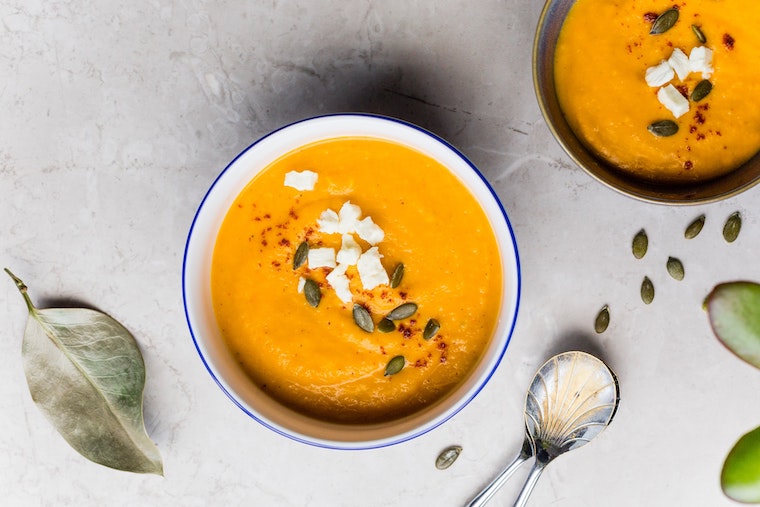5 Healthy Reasons to Eat Pumpkin in Seasons That Don’t Rhyme With Schmautumn
Pumpkin has a ton of healthy benefits to add nutrition to your diet and boost the taste of pretty much anything you’re craving. Sweet or savory—it complements both and is pretty low in calories, making it an excellent diet food. As if you needed more excuse to dig into pumpkin-spiced goodies all year long, here are five awesome benefits of your favorite orange-colored food.
1. It's high in vitamin A...
Eating pumpkin is good for your peepers. “One cup of pumpkin contains over 200 percent of the recommended daily intake of vitamin A, which is an important vitamin for eye health and night vision,” says Maggie Michalczyk, RD.
Pumpkin's bright orange color comes from its high beta-carotene concentration, she explains, and beta-carotene is a carotenoid (an antioxidant) and a precursor of vitamin A. Beta-carotene also helps protect us from the sun's harmful UV rays, so it’s great for keeping skin youthful and fresh.
2. ...and it's packed with vitamin C, too
“Pumpkin is a good source of vitamin C, an antioxidant known for strengthening the immune system and boosting collagen production (one of the reasons why you see so many skin products with pumpkin in them!),” she says. What’s more, it also improves iron absorption and studies show it reduces oxidative stress, which can prevent premature aging. One cup of pumpkin contains 19 percent of the recommended daily intake.

3. It'll fill you up fast
“It's recommended that Americans get between 25-35 grams of fiber per day (different depending on age and gender), which is something most of us do not get enough of,” she says. Since pumpkin is high in fiber, with one cup containing about 7 grams, it’ll fill you up and benefit your health.

{{post.sponsorText}}
“Fiber is needed for healthy digestion, it helps to lower cholesterol, and keeps us fuller for longer,” she says, so it’s a pretty important nutrient to get in the diet. And if you can get your fill with delicious pumpkin, why not?
4. It’s great for your muscles (and before bed)
“Pumpkin also contains magnesium, a mineral that many of us are not getting enough of and that is very important for many functions in the body like energy creation, muscle relaxation, and nervous system regulation,” she says. So, eating pumpkin after a tough workout can be especially helpful in recovery.
“Magnesium is especially important for active people working out a lot because during exercise your body redistributes magnesium to accommodate metabolic needs,” she says. That means you may be losing the magnesium stores in the muscles and must replenish them through food and drink.
In just 1 cup of pumpkin, you’ll get 14 percent of your daily value. And pumpkin seeds contain 37 percent of the daily requirement, so don't toss those when you're carving a pumpkin, she says. You can also add raw pumpkin seeds (pepitas) to salads, oatmeal, and yogurt for more magnesium and a boost of plant-based protein.
5. It has more potassium than a banana
“Pumpkin is high in potassium, a mineral necessary for muscle contraction, good digestion, water balance, and a healthy blood pressure,” she says. So, it’s pretty important, and people may forget to eat enough of it. As with magnesium, if you’re active and are depleting electrolytes, like potassium, it’s even more critical to restore levels. There's over 500 milligrams of potassium in a cup of canned pumpkin—more than what you'd get in a large banana.
How to enjoy pumpkin when it's not in season
Pumpkin is a super versatile vegetable, and you can easily put it in just about anything to add texture, flavor, and nutrition.
“Canned pumpkin is available year-round for as little as 99 cents in some grocery stores. My golden rule is to always have a can in your pantry for adding to things like oatmeal, pancakes, waffles, soups, chili, quesadillas, yogurt, energy bites, homemade face masks, and healthy desserts like these pumpkin chickpea blondies,” she says.
For the face mask, “pumpkin puree goes great with manuka honey and cinnamon, and a squeeze of lemon juice (mix together and keep on your face for 10-15 minutes and then rinse off) or you can also do a homemade sugar scrub with pumpkin puree, brown sugar, pumpkin pie spice and little bit of honey,” she says. (It sounds too good to simply lather on your face and not eat, though, right?)
You can also use pumpkin as a swap for eggs in recipes, such as baked goods, quick breads, muffins, cookies, and more. “Pumpkin puree can also double as a butter, oil, and egg replacer when modifying recipes for dietary restrictions. For reference you can replace 1 egg with 1/4 cup pumpkin puree,” she says.
Whatever you’re looking for, pumpkin can totally be a staple in your pantry all four seasons of the year. Super good for you and tasty, it can always use a little more year-round love.
When you are able to get your hands on fresh pumpkins, here are 6 tips for picking and cooking the nutrient-dense gourds. And to add some anti-inflammatory power, try this pumpkin-turmeric soup.
Loading More Posts...